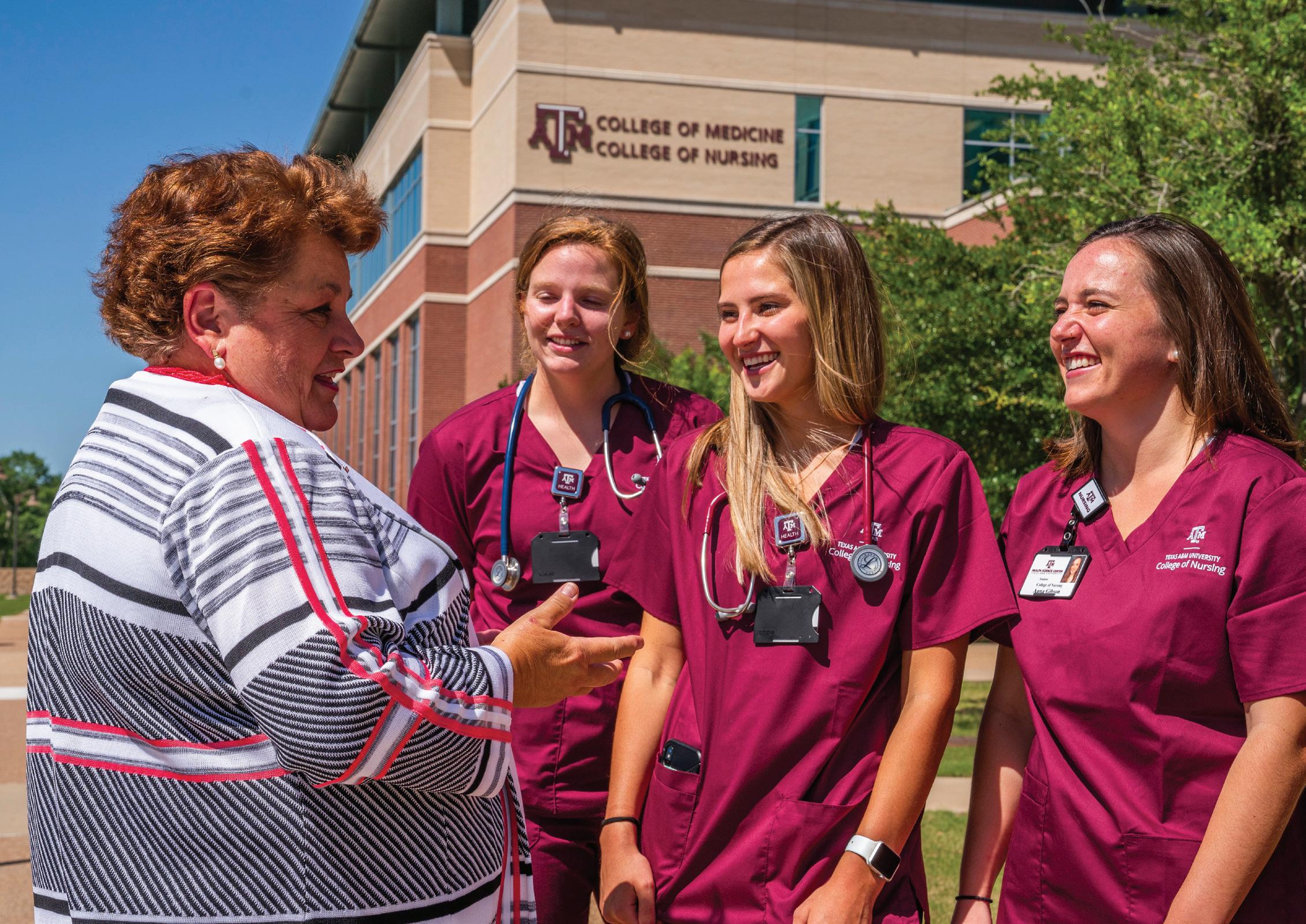
9 minute read
A ‘FAMILY’ PHYSICIAN
STORY BY DR. SHIRLEY LUNA ’85, ’06 & ’14 / PHOTOS BY SAM CRAFT ’04
Advertisement
PHYSICIAN NANCY W. Dickey ’72 was the first female president of the American Medical Association and helped write the Patient Bill of Rights. While she was president of the Texas A&M Health Science
Center, three campuses were added and enrollment increased from 880 students to more than 2,000.
Dickey now serves as executive director of the A&M Rural and
Community Health Institute, which serves in a consultative role with personnel from hundreds of hospitals and communities across the United
States to help improve access to quality health care.
Despite these incredible accomplishments, she still says some of her best memories are based on the relationships she developed as a family medicine physician.
NANCY DICKEY’S ACCOLADES:
Six honorary doctoral degrees in science and law
Citation of Merit Award – Texas Society of Pathologists, 1995
Elected to Institute of Medicine, 2007
Texas Women’s Hall of Fame, 2010
Senior Scholar – Association of Academic Health Centers, 2013
Trustee – Foundation for the History of Women in Medicine
John G. Walsh Award for Lifetime Contributions to Family Medicine – American Academy of Family Physicians, 2019
Higher education has played an important role in Dickey’s professional career, and one of her first experiences in higher education came when she attended a high school debate tournament on SFA’s campus.
“It happened to snow that weekend, and that very lovely campus became even more spectacular,” Dickey said. “My partner and I won the tournament at SFA, and a partial scholarship to SFA was part of the prize.”
Dickey later graduated from the University of Texas Medical School at Houston and is board certified in family medicine. In 1979, she was appointed director of patient education for the residency program. During this time, she also maintained a private practice and has delivered more than 4,000 babies during her career.
Her first child, Danielle, was born while Dickey was completing medical school. Her son, Wilson, was born during her residency, and her third child, Elizabeth, was born in the early years of Dickey’s private practice.
“I often had to advise my pregnant patients that I might be unable to attend them in childbirth if their due date was too close to mine,” she said. “I worked hard and put in long days. I coached soccer teams, led Brownie troops, and watched a lot of volleyball, basketball, and football games. I didn’t make it to all of the games, but we had a lot of fun. However, I’ve had students say to me they were told I ‘did it all’ — and they did not want to do it the way I did it.”
In 1996, Dickey joined the Texas A&M Health Science Center faculty and founded the family medicine residency of the Brazos Valley. Two years later, she was the first woman to be elected president of the American Medical Association. At that time, she was the youngest president ever to be elected by the organization.
In 2002, she was named president of Texas A&M’s Health Science Center. During her decade-long tenure, the center grew from four to six colleges — adding a College of Pharmacy and a College of Nursing. Dickey is now the president emeritus of the center and still lectures in the College of Medicine, but her primary work is dedicated to improving access to health care in rural areas through the A&M Rural and Community Health Institute, which was initiated during her leadership of the Health Science Center. It creates programs, policies and projects that help rural hospitals remain open and offers services at reasonable prices.
Looking back on a career that has included work as a health care provider, an educator and an administrative leader, at both facility and national levels, Dickey said caring for patients still defines her work.
“My 20 years of private practice provided the support for the other platforms, so from a ‘most meaningful’ perspective, I’d have to say that caring for patients meant the most. There are many patient stories I think of from time to time — the first patient whose baby I delivered and being in the ER when a colleague of my husband’s came in and was having a heart attack. Saving the life of a friend is part of small-town medicine.”
While personally fulfilling, the practice of medicine also provided a platform that led to other remarkable moments in Dickey’s career.
“The years leading up to being president of the AMA were a spectacular education in health policy and perspective of physicians from every specialty and every geography,” she recalled. “It was a joy to teach medical students and residents, and leading the Health Science Center was a tremendous honor. I think one of the signs of having had a fulfilling life is that there is no one moment that stands out — there are literally hundreds of them.”
But even physicians as accomplished as Dickey were impacted by the COVID-19 global pandemic. For a staff accustomed to a daily schedule of back-to-back meetings, the twomonth shutdown provided a travel reprieve and an introduction to the pros and cons of working from home.
“We do a tremendous amount of travel at the institute, reaching out to small towns across the U.S., and we spent January on the road,” she said. “We were saying we had to figure out how to get control of the travel and, all of a sudden, COVID hit. We weren’t in a plane for months.”
Although it was eye-opening, Dickey said she is not sure the pandemic will have a long-lasting effect on the way ARCHI does business.
“There is something very enlightening about going to a town and not just having a teleconference with the hospital CEO or chief nursing officer, but visiting with members of the community being served — to ask, ‘What do they do well?’ or ‘What do you wish they could add or fix?’” she said. “You come home with a much more intense flavor of the institution and a deeper understanding of what might be done.”
This difference is reflective of the overall mission of the institute — the importance of access to rural health care.
“There is nothing like driving for hours down a two-lane road, with sketchy cell service, and thinking, ‘If one of us develops chest pains, what are we going to do?’” she said. “It’s challenging for someone to develop a passion if they haven’t experienced one of those trips — whether the concern is the sheer distance or a winding mountain road or, in some cases, a driver from Texas realizing a blizzard is in the forecast. That creates a deep understanding of why local access to health care is important. Living in a rural area should not be a health risk.”
According to Dickey, the pandemic fastforwarded the prominence and prevalence of telemedicine by 10 to 15 years.
“We’ve changed regulations and policies; it is a true, meaningful part of delivering health care, particularly for rural areas and our aging population,” she said. “What a physician can do via phone or an 18-inch screen in terms of caring for a patient is different than what can occur in the exam room, but, especially if the physician sees the patient on a regular basis, telemedicine can be a powerful tool for chronic disease management, routine follow-up care and helping decide if a problem can wait until the next available clinic appointment or needs a visit to the emergency room.”
For the 2018-19 flu season, flu vaccination coverage among U.S. adults was 45%, but Dickey is hopeful that a coronavirus vaccine will be developed and administered to a greater percentage of the population.
“The flu vaccine admittedly only covers three strains of flu in any given year, and
it’s a gamble whether the right three strains are covered,” she explained. “However, any vaccine developed for the coronavirus should be directed specifically at SARS-CoV-2. So we really have to work hard to differentiate between flu and coronavirus, and we have to do a better job of getting a widespread base of the population back on the bandwagon for vaccines, in general.”
Dickey said, ironically, the reluctance of many individuals to get vaccinated is a result of the success of vaccines.
“Many people don’t remember when children died of measles — when meningitis, while it’s still a terrifying word, was not an uncommon word,” she said. “Through the efforts of Rotary and the Gates Foundation, we have almost wiped polio off the face of the Earth. That is remarkable if you think back to my parents’ generation when thousands of people contracted polio, and many ended up in iron lungs and with permanently crippled extremities. Because of vaccines, younger generations haven’t seen this. So it’s vital we educate the public that vaccines are major contributors to improved childhoods and to the opportunity to survive to adulthood.” ★
nancy dickey ’72

Making STORY BY AMY ROQUEMORE ’93 & ’12 Connections

University continues to serve students during pandemic
IN EARLY MARCH, SFA students’ slight concerns about COVID-19 were drowned out by excited buzz surrounding the impending spring break. With midterms finished and bags packed for visits home or road trips with friends, they departed campus and Nacogdoches in the usual droves, anticipating a respite from day-to-day college life and a return to their routines in a matter of days.
But it was not to be.
In response to the rapidly developing health emergency, SFA classes were moved online practically overnight, spring meetings and events were canceled, and students became full-time distance learners as the nation focused on flattening the curve. Meanwhile, all across campus, extraordinary efforts were being launched to ensure students remained connected to the critical support services, co-curricular programming and engagement opportunities that greatly contribute to the transformative educational experiences for which SFA is well known.
In the ensuing weeks, traditionally face-to-face activities — from peer tutoring to mental health counseling and from career coaching to exercise classes — were transitioned to online formats for the first time in school history. Even the SFA Spirit Teams tryouts were held online. As the semester rolled on, SFA hosted its first-ever 100% virtual commencement ceremony, transfer orientation, summer advising and registration, student government elections, service activities, and numerous special events and awards ceremonies.
“The overarching goal of SFA’s strategic plan is providing transformative student experiences, and one of the essential ways we accomplish that is through student engagement,” said Dr. Adam Peck, assistant vice president for university affairs and dean of student affairs. “When COVID-19 hit, this engagement became more essential and more challenging than ever. I am really proud of how our team adjusted to unprecedented changes and challenges while keeping the needs of our students at the forefront.”




